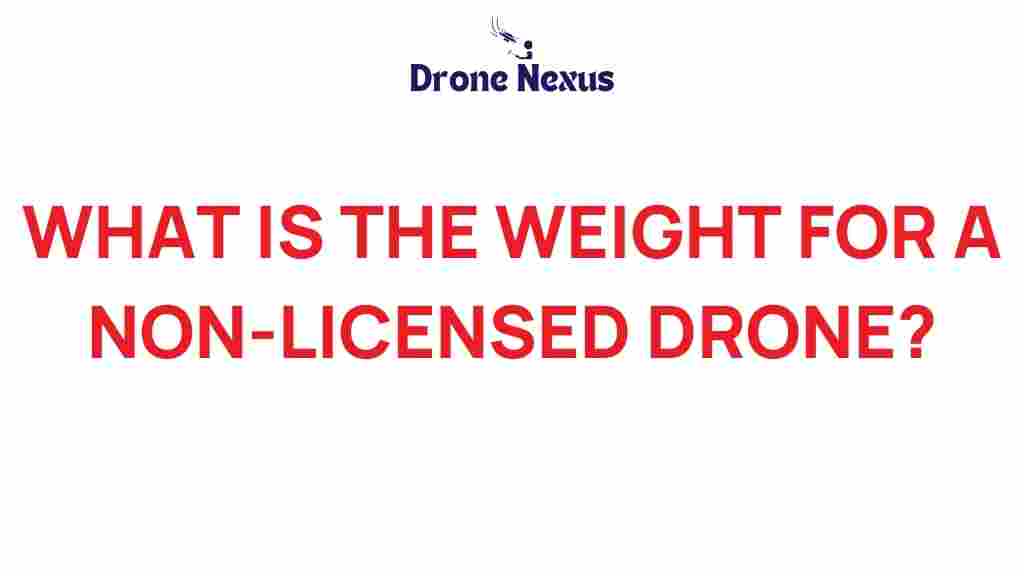The Hidden Weight of Non-Licensed Drones: What You Need to Know
In recent years, drones have gained immense popularity among hobbyists, photographers, and businesses alike. With their ability to capture stunning aerial footage and perform various tasks, drones have revolutionized many fields. However, a significant concern that often goes unnoticed is the prevalence of non-licensed drones. In this article, we will delve into what non-licensed drones are, the risks associated with them, and what you should know to ensure your safety and compliance.
Understanding Non-Licensed Drones
Non-licensed drones refer to unmanned aerial vehicles (UAVs) that operate without the necessary certifications or licenses required by aviation authorities. These drones can vary in size, capability, and purpose, from simple toys to sophisticated machines used for commercial activities. Using non-licensed drones can lead to various issues, including legal problems, safety risks, and even financial liabilities.
The Risks of Using Non-Licensed Drones
- Legal Consequences: Operating a non-licensed drone can result in hefty fines and legal action from aviation authorities. In many countries, drone operators must register their UAVs and adhere to specific regulations.
- Safety Hazards: Non-licensed drones often lack essential safety features, increasing the likelihood of accidents that can endanger people or property.
- Insurance Issues: If an accident occurs involving a non-licensed drone, your insurance may not cover damages, leaving you responsible for any costs incurred.
- Quality and Reliability: Non-licensed drones may not meet the same quality standards as licensed ones, leading to performance issues and malfunctions.
Step-by-Step Process: How to Ensure You’re Using a Licensed Drone
To avoid the pitfalls of non-licensed drones, follow these steps to ensure that you are operating a compliant UAV:
Step 1: Research Local Regulations
Before flying a drone, familiarize yourself with the regulations in your area. Each country has different rules regarding drone operation, registration, and licensing. In the United States, for example, the Federal Aviation Administration (FAA) requires drone operators to register their UAVs that weigh more than 0.55 pounds.
Step 2: Register Your Drone
If your drone falls under the registration requirements, make sure to register it with the appropriate authority. This process usually involves providing details about the drone and paying a registration fee.
Step 3: Obtain Necessary Licenses
For commercial drone use, you may need to obtain a specific license, such as the FAA’s Part 107 certification in the United States. This certification involves passing an aeronautical knowledge test that covers various topics, including airspace regulations and safety procedures.
Step 4: Invest in Quality Equipment
Choose a reputable brand and model that complies with safety and regulatory standards. Investing in a quality drone not only enhances performance but also reduces the chances of accidents.
Step 5: Follow Safety Protocols
Always adhere to safety guidelines when flying your drone. This includes avoiding restricted airspace, maintaining a visual line of sight, and ensuring your drone is well-maintained.
Troubleshooting Tips for Non-Licensed Drones
Even with proper precautions, issues can arise when flying non-licensed drones. Here are some troubleshooting tips to help you navigate common problems:
1. Connectivity Issues
If your drone is losing connection during flight, consider the following:
- Ensure that your remote control is charged and functioning.
- Check for interference from other electronic devices.
- Fly in open areas away from tall buildings or dense foliage.
2. Battery Problems
Battery life is crucial for drone operation. If you notice a rapid decrease in battery life, try these tips:
- Calibrate the battery before flights.
- Store batteries in a cool, dry place when not in use.
- Replace old or damaged batteries immediately.
3. Camera Malfunctions
If you encounter issues with your drone’s camera, consider the following steps:
- Ensure that the camera lens is clean and free of obstructions.
- Check the camera settings and adjust them to your preferences.
- Restart the drone to reset the camera function.
Conclusion
While non-licensed drones can offer a thrilling experience and numerous benefits, the hidden risks and potential consequences are significant. By understanding the importance of operating licensed drones, you can ensure your safety, adhere to regulations, and protect yourself from legal and financial liabilities.
Remember to always do your research, register your drone, obtain necessary licenses, and follow safety protocols. Taking these steps will help you enjoy the exciting world of drone flying without the hidden weight of non-licensed drones weighing you down.
For more information on drone regulations and safety guidelines, visit the FAA’s official website. And if you’re looking for reputable drone brands, check out this resource for recommendations.
This article is in the category Safety and created by DroneNexus Team
